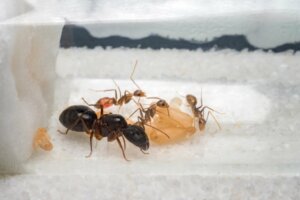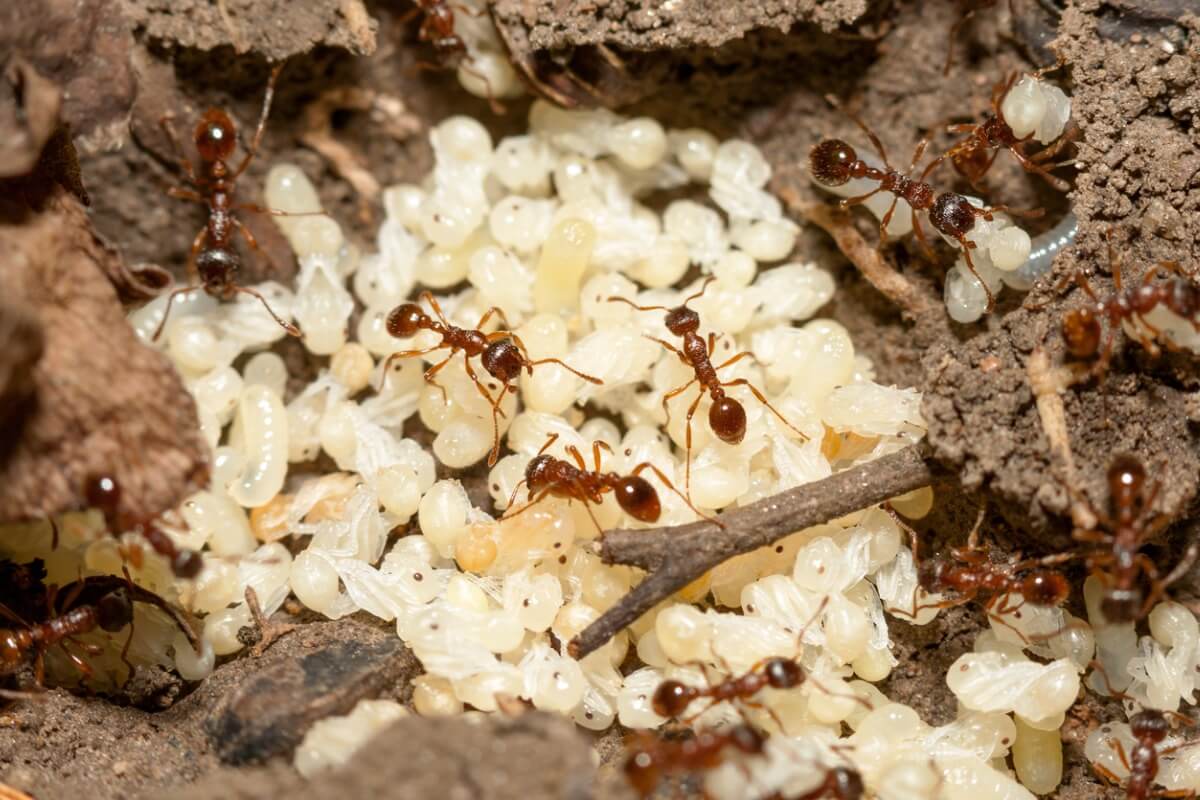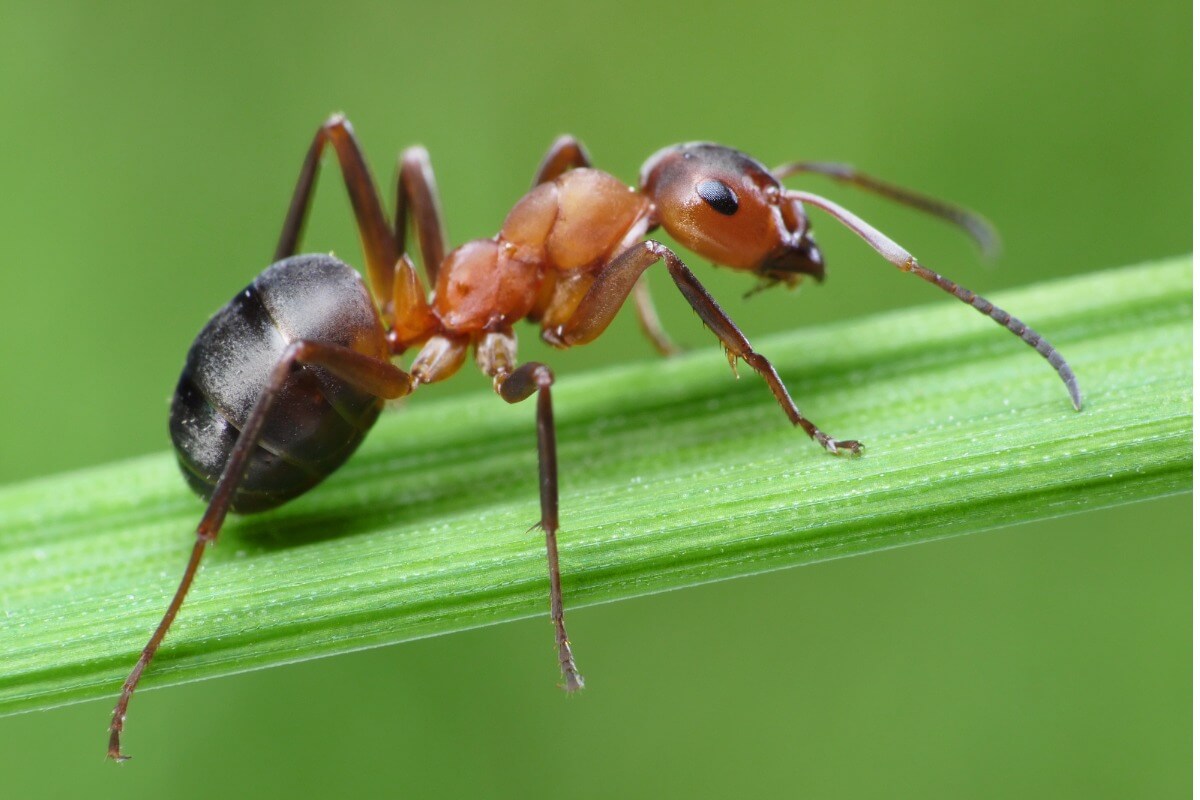First Steps in Looking After an Ant Colony


Written and verified by the biologist Samuel Sanchez
Ants are a group of hymenopterous insects belonging to the Formicidae family. They’re an extremely diverse taxon that has colonized almost every environment in the world, resulting in more than 22,000 species existing today (of which only about 13,800 have been described). It’s estimated that these animals make up 15-25% of the terrestrial animal biomass. Today we’ll shed light on how to start your own ant colony!
There are many species within this fascinating group and each has its own needs, but there are a number of universal tips that every breeder should keep in mind if they want to look after an ant colony in the long term. Here we’ll show you the basics of this exciting hobby.
1. Be clear about the basics of an ant colony
You’ll probably start off with a wingless queen in a glass or plastic tube. Most ant colonies are established in captivity from a single fertilized female, a process known as foundation. Before you consider keeping an ant colony in the long term, you should be clear about the castes that make it up:
- Queen: She is the heart of the anthill and, in most cases, the only specimen capable of laying fertilized eggs. The queen is born with wings and leaves her primitive colony in search of males. Once she is fertilized, she keeps the sperm of several of them in her spermatheca, removes her wings, and buries herself. Some queens live up to 30 years.
- Workers: These are born from fertilized eggs laid by the queen, but they don’t have the ability to reproduce and don’t have wings when they hatch. They’re in charge of expanding the nest, maintaining the larvae, preserving the queen, and foraging for food. They live much less than their mother (generally less than 1 year) and can number thousands in the colony.
- Males: Males hatch from unfertilized eggs that the female lays when the colony is large enough. They’re always winged and their only mission is to reproduce, after which they die in a few days.
- Princesses: These are potential queens that are born with wings when the colony has matured. They take flight if the conditions are favorable and look for fertilization to found a new anthill.
During the early stages of the colony, the queen will lay eggs that will give rise only to workers, which are known as nurses. As these are born in somewhat harsh conditions and their mother’s energy reserves are limited, they live less than normal workers.

2. Identify the species you have acquired
Before proceeding, you should be clear about the requirements of your species. Some queens are claustral and rely on their energy reserves to lay their first eggs until the brood hatches, while others are semi-claustral and need to go out to a foraging area to hunt and consume protein.
On the other hand, the characteristics of the species will dictate the conditions you need to maintain your queen or colony. European ants can usually tolerate wide temperature ranges (15-30°C), while tropical ants should not fall below 23-24°C at almost any time. Relative humidity is also a parameter to take into account.
Some species of arid climates require humidities of 50-60%, while certain Asian ants need 90% or more.
3. The tube will be your best ally
As we have said, the vast majority of queens are purchased from stores in a tube with a “drinker” integrated at the end (wet cotton wool). This is a more than adequate means of foundation in claustral species, as it provides the queen with sufficient moisture to hydrate and lay her eggs. In these cases, you won’t even need to feed her.
When the first nurses hatch you should start providing the colony with food in the form of sugary nectar and dead insects (in most cases, but not all). Don’t be in a hurry and don’t move the ants out of the tube until you observe about 20-25 workers. Moving them into a too-spacious nest prematurely will only cause them to become stressed and die.
This rule doesn’t apply to semi-claustral species. Some queens are hunters and require a foraging area to hunt even on their own.
4. Feed the ants according to their requirements
The first workers will be tasked with feeding the queen and nurturing her while she lays the next batch of eggs. You’ll be able to see how they do it through trophallaxis, that is, the direct transmission of liquids from the nurse’s mouth to her progenitor.
At this point, you should be very clear about what exactly the species eats in order to take care of your ant colony. Most specimens included in the subfamily Formicinae feed on dead protein (remains of meat and dying insects) and nectar. On the other hand, the subfamily Ponerinae is much more aggressive and its specimens actively hunt live invertebrates.
The species Messor barbarus, one of the most typical, feeds mainly on seeds. However, the standard genera (such as Camponotus) only require dead protein and sugary nectar.
5. Choose the right anthill
Once the colony is big enough, you’ll have to tip the tube (gently) or connect it to an anthill for the workers and the queen to move in. It’s very important to choose a suitable installation for the species, because it’s very common for the colony to be ruined by choosing a bad nest after the founding stage inside the tube.
It’s very important that you don’t use sandwich-type nests (sand between 2 panes), with gels or other foreign materials. Look for installations made with specific acrylics for ants, even better if they are anti-leakage. Some models are specific for species that require high humidity and have water towers or sponges with reservoirs to hydrate the environment.
On the other hand, ytong-type ant nests will be very useful for tropical species that require exceptionally high humidity. Keep in mind that you will have to inject these facilities with water from time to time to keep this value at a constant 90%.
Taking care of your ant colony: enjoy it and don’t let your guard down!
Once the queen and workers have moved in and the nest has about 40-50 individuals, the foundation is finished and the colony will start to grow exponentially. It’s difficult for the queen to die at this point, but you should never let your guard down. Follow the tips we’ll tell you now to take care of your ant colony effectively at all times:
- Remove any remains that aren’t ingested on a regular basis. Failure to do so will encourage long-term infections and disease in the colony.
- Diapause (if the species requires it). Some species of ants need a drop in temperature during the winter to thrive, similar to mammalian hibernation. Don’t skip this step if your colony needs it.
- Watch out for mites. Mites are one of the biggest threats in the hobby of myrmecology. If you detect them in any of your ant nests, lower the humidity drastically (less than 60%) and isolate the colony until it is disinfected.

Apart from all of the above, you should keep in mind that not all species are maintained in the same way, and some have very specific requirements. The secret to taking care of an ant colony in the long term is to inform yourself extensively about the requirements of the specific specimens before you buy them and during the maintenance of the nest.
Ants are a group of hymenopterous insects belonging to the Formicidae family. They’re an extremely diverse taxon that has colonized almost every environment in the world, resulting in more than 22,000 species existing today (of which only about 13,800 have been described). It’s estimated that these animals make up 15-25% of the terrestrial animal biomass. Today we’ll shed light on how to start your own ant colony!
There are many species within this fascinating group and each has its own needs, but there are a number of universal tips that every breeder should keep in mind if they want to look after an ant colony in the long term. Here we’ll show you the basics of this exciting hobby.
1. Be clear about the basics of an ant colony
You’ll probably start off with a wingless queen in a glass or plastic tube. Most ant colonies are established in captivity from a single fertilized female, a process known as foundation. Before you consider keeping an ant colony in the long term, you should be clear about the castes that make it up:
- Queen: She is the heart of the anthill and, in most cases, the only specimen capable of laying fertilized eggs. The queen is born with wings and leaves her primitive colony in search of males. Once she is fertilized, she keeps the sperm of several of them in her spermatheca, removes her wings, and buries herself. Some queens live up to 30 years.
- Workers: These are born from fertilized eggs laid by the queen, but they don’t have the ability to reproduce and don’t have wings when they hatch. They’re in charge of expanding the nest, maintaining the larvae, preserving the queen, and foraging for food. They live much less than their mother (generally less than 1 year) and can number thousands in the colony.
- Males: Males hatch from unfertilized eggs that the female lays when the colony is large enough. They’re always winged and their only mission is to reproduce, after which they die in a few days.
- Princesses: These are potential queens that are born with wings when the colony has matured. They take flight if the conditions are favorable and look for fertilization to found a new anthill.
During the early stages of the colony, the queen will lay eggs that will give rise only to workers, which are known as nurses. As these are born in somewhat harsh conditions and their mother’s energy reserves are limited, they live less than normal workers.

2. Identify the species you have acquired
Before proceeding, you should be clear about the requirements of your species. Some queens are claustral and rely on their energy reserves to lay their first eggs until the brood hatches, while others are semi-claustral and need to go out to a foraging area to hunt and consume protein.
On the other hand, the characteristics of the species will dictate the conditions you need to maintain your queen or colony. European ants can usually tolerate wide temperature ranges (15-30°C), while tropical ants should not fall below 23-24°C at almost any time. Relative humidity is also a parameter to take into account.
Some species of arid climates require humidities of 50-60%, while certain Asian ants need 90% or more.
3. The tube will be your best ally
As we have said, the vast majority of queens are purchased from stores in a tube with a “drinker” integrated at the end (wet cotton wool). This is a more than adequate means of foundation in claustral species, as it provides the queen with sufficient moisture to hydrate and lay her eggs. In these cases, you won’t even need to feed her.
When the first nurses hatch you should start providing the colony with food in the form of sugary nectar and dead insects (in most cases, but not all). Don’t be in a hurry and don’t move the ants out of the tube until you observe about 20-25 workers. Moving them into a too-spacious nest prematurely will only cause them to become stressed and die.
This rule doesn’t apply to semi-claustral species. Some queens are hunters and require a foraging area to hunt even on their own.
4. Feed the ants according to their requirements
The first workers will be tasked with feeding the queen and nurturing her while she lays the next batch of eggs. You’ll be able to see how they do it through trophallaxis, that is, the direct transmission of liquids from the nurse’s mouth to her progenitor.
At this point, you should be very clear about what exactly the species eats in order to take care of your ant colony. Most specimens included in the subfamily Formicinae feed on dead protein (remains of meat and dying insects) and nectar. On the other hand, the subfamily Ponerinae is much more aggressive and its specimens actively hunt live invertebrates.
The species Messor barbarus, one of the most typical, feeds mainly on seeds. However, the standard genera (such as Camponotus) only require dead protein and sugary nectar.
5. Choose the right anthill
Once the colony is big enough, you’ll have to tip the tube (gently) or connect it to an anthill for the workers and the queen to move in. It’s very important to choose a suitable installation for the species, because it’s very common for the colony to be ruined by choosing a bad nest after the founding stage inside the tube.
It’s very important that you don’t use sandwich-type nests (sand between 2 panes), with gels or other foreign materials. Look for installations made with specific acrylics for ants, even better if they are anti-leakage. Some models are specific for species that require high humidity and have water towers or sponges with reservoirs to hydrate the environment.
On the other hand, ytong-type ant nests will be very useful for tropical species that require exceptionally high humidity. Keep in mind that you will have to inject these facilities with water from time to time to keep this value at a constant 90%.
Taking care of your ant colony: enjoy it and don’t let your guard down!
Once the queen and workers have moved in and the nest has about 40-50 individuals, the foundation is finished and the colony will start to grow exponentially. It’s difficult for the queen to die at this point, but you should never let your guard down. Follow the tips we’ll tell you now to take care of your ant colony effectively at all times:
- Remove any remains that aren’t ingested on a regular basis. Failure to do so will encourage long-term infections and disease in the colony.
- Diapause (if the species requires it). Some species of ants need a drop in temperature during the winter to thrive, similar to mammalian hibernation. Don’t skip this step if your colony needs it.
- Watch out for mites. Mites are one of the biggest threats in the hobby of myrmecology. If you detect them in any of your ant nests, lower the humidity drastically (less than 60%) and isolate the colony until it is disinfected.

Apart from all of the above, you should keep in mind that not all species are maintained in the same way, and some have very specific requirements. The secret to taking care of an ant colony in the long term is to inform yourself extensively about the requirements of the specific specimens before you buy them and during the maintenance of the nest.
All cited sources were thoroughly reviewed by our team to ensure their quality, reliability, currency, and validity. The bibliography of this article was considered reliable and of academic or scientific accuracy.
- Smith, C. R., & Suarez, A. V. (2010). The trophic ecology of castes in harvester ant colonies. Functional Ecology, 24(1), 122-130.
- Campbell, K. U., Klompen, H., & Crist, T. O. (2013). The diversity and host specificity of mites associated with ants: the roles of ecological and life history traits of ant hosts. Insectes Sociaux, 60(1), 31-41.
- Philpott, S. M., Perfecto, I., Armbrecht, I., & Parr, C. L. (2010). Ant diversity and function in disturbed and changing habitats. Ant ecology, 1, 137-156.
This text is provided for informational purposes only and does not replace consultation with a professional. If in doubt, consult your specialist.








